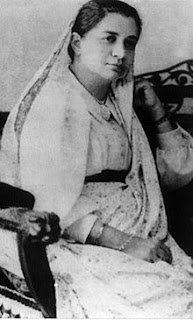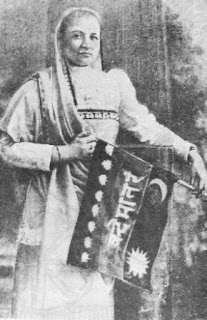Madam Cama was born on 24th September, 1861 at Mumbai in a rich
Parsi family. Her mother’s name was Jayji and her father’s name was
SorabjiFramji Patel. Her father and brother were big traders in Mumbai. They
had a palatial residence at Cumballa Hill. The parents named their daughter as
Bhikaji. Madam Cama, who completed her schooling in Mumbai, was fluent in four
languages English, Gujarati, Hindi and Marathi.
On 3rd August, 1885 she was married to Rustom Khurshid Cama who was solicitor by profession, but soon she had to dessert her misbehaving husband who insulted her wifehood. Though the family life was destroyed she did not sit idle. She dedicated herself to social work. In 1896 Mumbai was struck with the Plague epidemic. During that time she, along with other females, served the patients at Parsi Fever Hospital. During the 1899 plague epidemic, she herself was infected with the disease. After recovering, on medical advice, she went to Europe. In Europe she stayed in Germany, France and Scotland for one year each. During her stay she underwent a surgery. On improvement in health, i.e. in 1905, she came to London. There she started participating in activities of Dadabhai Nowrojee’s ‘London India Society’. She became close to ‘India House’, which was the safe haven for Indian revolutionaries. She started delivering fierce speeches regarding Freedom of India, at places like Hyde Park in London. During the same time i.e. on 24th June, 1906 a young man named Vinayak Damodar Savarkar reached London.
On 3rd August, 1885 she was married to Rustom Khurshid Cama who was solicitor by profession, but soon she had to dessert her misbehaving husband who insulted her wifehood. Though the family life was destroyed she did not sit idle. She dedicated herself to social work. In 1896 Mumbai was struck with the Plague epidemic. During that time she, along with other females, served the patients at Parsi Fever Hospital. During the 1899 plague epidemic, she herself was infected with the disease. After recovering, on medical advice, she went to Europe. In Europe she stayed in Germany, France and Scotland for one year each. During her stay she underwent a surgery. On improvement in health, i.e. in 1905, she came to London. There she started participating in activities of Dadabhai Nowrojee’s ‘London India Society’. She became close to ‘India House’, which was the safe haven for Indian revolutionaries. She started delivering fierce speeches regarding Freedom of India, at places like Hyde Park in London. During the same time i.e. on 24th June, 1906 a young man named Vinayak Damodar Savarkar reached London.
Rise Of First
Indian Flag
Madam Cama with the first Indian Flag
During the stay in London, Madam Cama received an invitation of the
“International Socialist Conference” which was scheduled to start on 18th
August 1907. The conference was being held since the previous ten years. This
time the venue for the Annual meet was Stuttgart, in Germany. Savarkar always
attempted to garner International support for the issue of Independence for
India. Savarkar suggested that Madam Cama and Barrister Sardarsingh Rana should
attend the conference as representatives of India. Savarkar also drafted the
resolution that was to be proposed there.
On deciding that Madam Cama would propose the resolution during the
conference, Savarkar realized that our nation does not have an independent flag
for unfurling there. (Congress always hailed and pompously marched the British
Union Jack, considering it to be Hindustan’s flag). Savarkar did not sit idle.
From his talented personality Hindustan’s Tricolour, the first national flag,
was born. Savarkar’s genius was so remarkable that all the flags that were used
during freedom struggle and later had a set of three colours.
Madam Cama and Bhanumatiji, the wife of ShriShamji Krishna Varma,
themselves stitched this flag, using rich satin and silk cloth of the same
three colours. Three such flags were made. The reason being, in the event of
seizure of one during police action, the other could be used. To avoid any
obstacle that could be created by anybody, Madam Cama carried one flag out of
England, having hidden it in her blouse. Barrister Rana carried the other two
flags to Paris. Around this time, the British government ordered Madam Cama to
leave England. Madam Cama shifted her base to Paris, capital of France. It’s
from Paris that she went to Stuttgart.
The Meaning of
Colours and Symbols of the Flag hoisted by Madam Cama
On
21st August, 1907, at the International Socialistic Conference, when Madam Cama
unfurled the flag, she also explained the meaning of its colours and symbols.
The top stripe of the Flag was Green in colour. The Eight provinces of India of
those days were represented by eight lotus flowers. The slogan “VandeMataram”
for which hundreds of youngsters got their heads broken and also chanted the
same while being hanged was inscribed on the centre saffron stripe. The Sun and
Moon on the bottom red stripe indicated that India would remain Independent
till Sun and Moon continued to grace the skies.
The
Green colour reflected Courage and Spirit. The Saffron colour indicated victory
and Red colour displayed Strength. After reading out the resolution Madam Cama
delivered a straightforward speech. At the end of the speech, waving the flag
she said “Before I end my speech, I want to tell you that, while I am alive I
completely hope to see that the Republican State of India is formed.
VandeMataram”.
Later
on during meetings of revolutionaries in Paris, a smaller version of the flag
was always placed in the center of Madam Cama’s table. She also got one badge
of the same flag made. She always carried the badge on her chest.
After
the conference Madam Cama was invited by American Nationalists in order to
propagate the Indian freedom struggle. On 19th October, 1907 she reached
America. Even in America, in front of the locals, through her speeches she
exposed the British suppression in India.



No comments:
Post a Comment